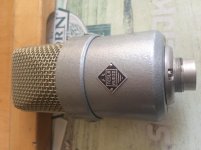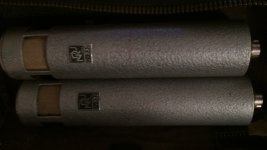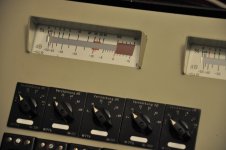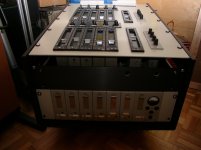Take care Andy, you're opening a can of worms...
But OK, to give you a nice starter, here is my take of what IMVHO is the most important in a (SE) tube amplifier:
1. power supply (after all, an amplifier modulates the power supply into AF so there you are);
2. circuit design;
3. transformers;
4. choice of tubes.
So yes, choice of tubes comes last!
So, be aware of the limitation of your question...
Tizman....many many years back I used C3M to drive 300b both in pentode and triode mode, it was OK but not what I was longing for. Soon after I converted it for E180F in triode mode and that was better for my liking. Right now I use EF184 in triode choke loaded and that's it for my taste.
I like to try DC config next and A2 with proper A2 capable TT tube.
Regards
I like to try DC config next and A2 with proper A2 capable TT tube.
Regards
Does anyone have an amp with a C3M driving a 300B? If so, what does it sound like?
I am playing with a 300B and C3M driver. Until now it is still very satisfying! Plays on 2 La Scala's, and with the DDDAC or records with Garrard 401.
Somewhere on the net you can find my amp at Audio-Creative. Sorry story is in dutch.
good luck
So, be aware of the limitation of your question...
to me, choice of speakers comes first, once you know what speaker you are diving, the amplifier is easy to decide on....
When I built my first tube amp, it was a single ended, triode wired EL84. The speakers that I had at the time were ADS L810, which are nice speakers, but not quite sensitive enough for that amp. The sound of that amp drove me towards higher sensitivity speakers. In my case the amp led me to the speakers I could use. Choosing a speaker first can be very limiting with respect to amp choices. The sound of that first amp changed everything for me in a way that listening to many different speakers did not.
Congrats for your effort! Interesting, is a chopper impedance converter like the Berning uses, or some variation?Again, my complete 300b amp with integrated power supply and frequency range from 2Hz to 40Khz.
Can be lifted with one hand, is ultra quiet and very dynamic.
No "3-legged fuses" explosions or RF interference in developing stages?
One can sometimes have a fear if this things have some RF emission penalty
You compared your creation with a "traditional trafo coupled" one (commercial or DIY) for curiosity (soundwise)?
I have build several of these amps as i am a big fan...
There is a thread dedicated for the Zotl amps:
ZOTL and ferrites
Soundwise, i can only say that the tube used is "naked" (like in "naked truth"). I must be carefull claiming this here as some are very religeous of their output transformers (heavier is better etc.)
We will see who will react on this, ha ha....
There is a thread dedicated for the Zotl amps:
ZOTL and ferrites
Soundwise, i can only say that the tube used is "naked" (like in "naked truth"). I must be carefull claiming this here as some are very religeous of their output transformers (heavier is better etc.)
We will see who will react on this, ha ha....
Last edited:
The main advantage of an audio signal transformer is to completely decouple the amp from the speakers. There are two independent circuits, primary and secondary, that are only coupled by magnetic fields.Congrats for your effort! Interesting, is a chopper impedance converter like the Berning uses, or some variation?
No "3-legged fuses" explosions or RF interference in developing stages?
One can sometimes have a fear if this things have some RF emission penalty
You compared your creation with a "traditional trafo coupled" one (commercial or DIY) for curiosity (soundwise)?
The main disadvantage for an audio signal transformer is that good examples cost a bunch of money while badly designed and cheap transformers are the only option for this reason for the not so wealthy DIY.
In that case, before choosing a cheap audio transformer, maybe its a good idea to go OTL, ZOTL or whatever you call it.
But for someone who can afford good transformers, the disadvantages doesn't exist but only the advantages exist.
I would never come to the idea to swap an audio transformer out of the amp, because thats what gives music its energy, spirit and dynamic contrasts.
For me, this is an essential part of a tube amp and its sound quality.
The main disadvantage for an audio signal transformer is that good examples cost a bunch of money while badly designed and cheap transformers are the only option for this reason for the not so wealthy DIY.
In that case, before choosing a cheap audio transformer, maybe its a good idea to go OTL, ZOTL or whatever you call it.
I don't think it's a question of "good and bad" in OPTs - especially not something directly linked to price, though cost comes into it of course. It's more a question of 50 shades of grey. OPTs get steadily better as you move up the quality ladder, and it's up to your budget and skill in finding bargains in used OPTs as to where you end up. There are some pretty good medium level OPTs like Lundahl and others, without going for silver wire and all the boutique options.
For instance I have LL1682/50, O-Netics Wright Sound 3.5K, O-Netics Level 1 3.5K, and NP Acoustics amorphous 3.5K. I like all of them and it's more a case of each one sounding a little different one from another.
.
Last edited:
BTW OTL and Zotl are different approaches and not to be compared technically. The outcome is similar but in case of a traditional OTL the tubes need to deliver current and in Zotl they need to give a high voltage swing ( the latter is perfect for any tube). This can be heard as no tube is stressed to the max in a Zotl amp and will be able to perform as its best.
It must be heard to believe as looking at the circuit does not show this.
It must be heard to believe as looking at the circuit does not show this.
Why not build one of those early transistor designs?
You don't need an output transformer, which is so baaadly and just makes an amp sounds more worse, and the circuits sounded just fine. Of course, you need old parts to build an old amp, otherwise it will sound like a new one. Tube technology did build inherently upon audio transformers. If you don't like or get the idea behind it, well, more modern technologies got all rid of those precious parts. And you know what, they doesn't got start to sound better. A heavy iron amp could be beaten not easily. That was fact in the past, and thats still true. Because it has this massive amount of magnetic force with authority. An OTL amp will never have this, this is just toying around with electron tubes.
You don't need an output transformer, which is so baaadly and just makes an amp sounds more worse, and the circuits sounded just fine. Of course, you need old parts to build an old amp, otherwise it will sound like a new one. Tube technology did build inherently upon audio transformers. If you don't like or get the idea behind it, well, more modern technologies got all rid of those precious parts. And you know what, they doesn't got start to sound better. A heavy iron amp could be beaten not easily. That was fact in the past, and thats still true. Because it has this massive amount of magnetic force with authority. An OTL amp will never have this, this is just toying around with electron tubes.
Last edited:
The point is that i like to hear a recording as it was supposed to sound (as far as this is possible) and transistors do not help here for the same reason why transformers do not help. When recording i use tools i think appropriate to get the sound i would like (vintage or modern). So it is fine that some like to adjust the recording to their taste afterwards (same as adding Ketchup on a every meal).
Attachments
Me, too. But I don't see why all those audio transformers should be a bad design feature or, like you wrote, are like adding Ketchup to a good meal.
Interesting enough, you show famous tube audio equipment with much transformers involved. When going to my LP rack, many of those best sounding records were produced with this kind of equipment. Therefore they all should be rubbish, in your ears.
Unfortunately, are the later ones, done without this kind of equipment but with transistor equipment, exactly what you say that this classic tube equipment is. Less lifelike, less vibrant sounding, sterile and robbed all colors.
So your statement has been proven wrong, prejudiced by your high technology appeal. The facts speak another language.
Btw, every single part does colorations to the music. The straigt wire amp theory lacks proove in practice. It has never worked out and will never do.
But that to understand means to have an open mind and no prejudices towards a classic technology, which has produced some of the best recordings of all time.
The real skill in tube audio isn't to get rid of all those transformers (which is absolutely impossible, as the PSU transformer is just another "sounding" part of an amp), but to have them being applied in a manner that good sound will be the result. Many fail for this aim, because of lack of budget or lack of circuit design excellence.
Good luck with your OTL, Zotl or whatever audio designs!
Interesting enough, you show famous tube audio equipment with much transformers involved. When going to my LP rack, many of those best sounding records were produced with this kind of equipment. Therefore they all should be rubbish, in your ears.
Unfortunately, are the later ones, done without this kind of equipment but with transistor equipment, exactly what you say that this classic tube equipment is. Less lifelike, less vibrant sounding, sterile and robbed all colors.
So your statement has been proven wrong, prejudiced by your high technology appeal. The facts speak another language.
Btw, every single part does colorations to the music. The straigt wire amp theory lacks proove in practice. It has never worked out and will never do.
But that to understand means to have an open mind and no prejudices towards a classic technology, which has produced some of the best recordings of all time.
The real skill in tube audio isn't to get rid of all those transformers (which is absolutely impossible, as the PSU transformer is just another "sounding" part of an amp), but to have them being applied in a manner that good sound will be the result. Many fail for this aim, because of lack of budget or lack of circuit design excellence.
Good luck with your OTL, Zotl or whatever audio designs!
Last edited:
- Home
- Amplifiers
- Tubes / Valves
- 300b with single stage driver, C3M or?



